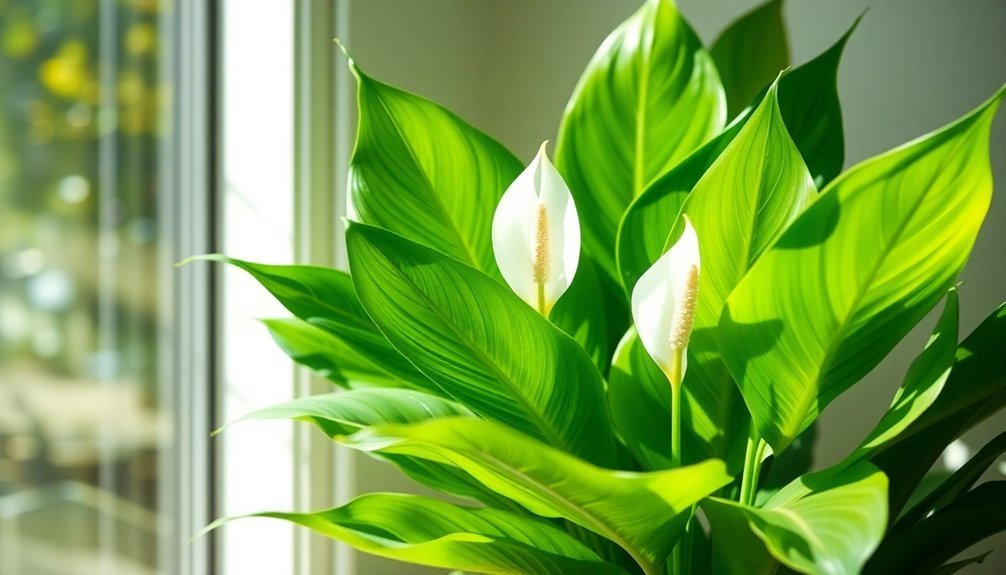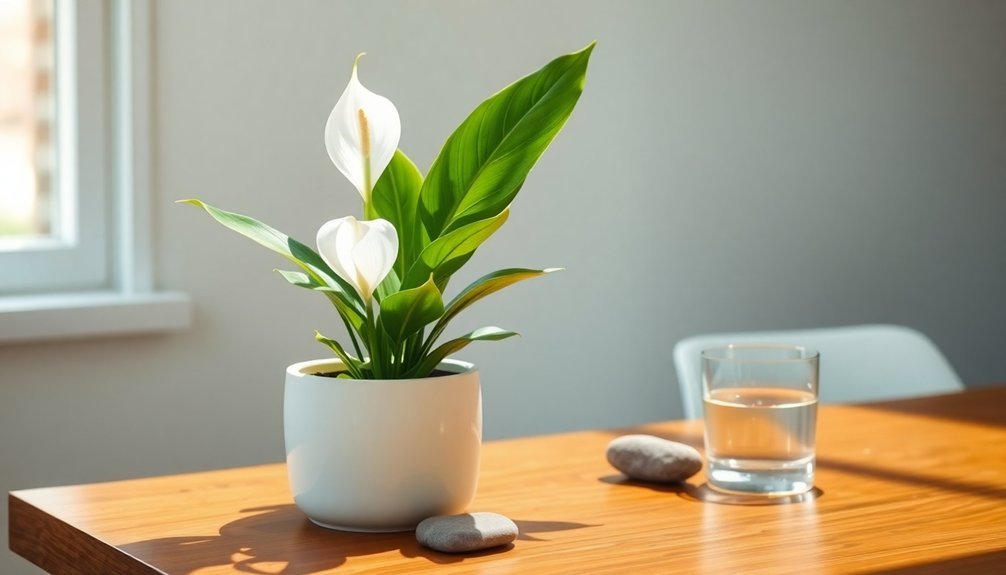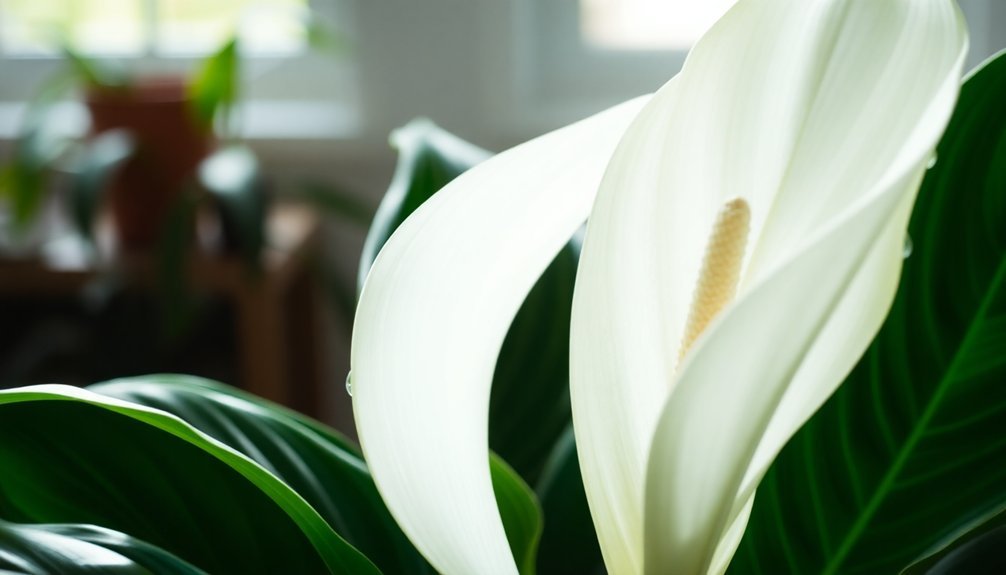Your peace lily isn't just a pretty plant – it's a NASA-proven air purification powerhouse that can remove up to 60% of indoor toxins within 24 hours. Place it near north or east-facing windows, water when the top inch of soil feels dry, and watch for glossy leaves as a sign of active filtering. By pairing it with other air-cleaning plants like snake plants or bamboo palms, you'll create a natural air-purifying system. There's much more to discover about maximizing your peace lily's potential.
The NASA-Backed Science of Peace Lily Purification

When NASA conducted its groundbreaking Clean Air Study, the Peace Lily emerged as a star performer in removing indoor air pollutants.
You'll find these remarkable plants working tirelessly to eliminate harmful substances like formaldehyde, benzene, and trichloroethylene from your living space.
The process is fascinating: Peace lilies absorb toxins through their leaves and transport them to their root system, where helpful microorganisms break down these dangerous compounds.
Nature's elegant solution: Peace lilies work with microscopic allies to transform harmful pollutants into harmless substances through their leaf-to-root filtration system.
What's even better is that you don't need many plants to see results – just a few strategically placed Peace lilies can considerably improve your indoor air quality.
They're particularly valuable because they thrive in low-light conditions while maintaining their air-purifying efficiency.
As an added bonus, they'll naturally increase humidity levels, making your indoor environment more comfortable.
Common Household Toxins Your Peace Lily Battles
Living spaces harbor numerous hidden toxins that might surprise you, but your Peace Lily stands ready as a natural defender.
NASA's clean air study identified these plants as powerhouses in removing common household toxins that lurk in your home.
Your Peace Lily works tirelessly to combat these harmful substances:
- Formaldehyde – often found in pressed wood products and insulation
- Benzene – present in plastics and synthetic fibers
- Trichloroethylene – commonly found in cleaning products
- Toluene and xylene – hidden in paints and varnishes
What's remarkable is how your Peace Lily processes these toxins. Its leaves absorb the harmful substances and send them to the roots, where beneficial microorganisms break them down.
Setting Up Your Natural Air-Cleaning Station

Your Peace Lily's air-cleaning power starts with perfect placement near north or east-facing windows, where it'll receive bright, indirect light while maintaining ideal room temperature.
You'll need to monitor your plant's water needs by checking soil moisture regularly and watching for drooping leaves as natural indicators of thirst.
To maximize your air-purifying station's effectiveness, keep humidity levels high by placing a water tray nearby or using a humidifier, especially in drier indoor environments.
Choosing Perfect Plant Placement
Finding the perfect spot for your peace lily can transform it from a struggling houseplant into a thriving natural air purifier. Your plant's location plays a significant role in its ability to clean your indoor air effectively while maintaining its health and liveliness.
Here's how to position your peace lily for peak performance:
- Place it near north or east-facing windows to capture gentle indirect light without risking leaf damage.
- Keep it away from heating vents, radiators, and appliances that emit warmth.
- Set up a humidity zone with a nearby water tray or humidifier.
- Monitor its environment regularly to guarantee it mimics the plant's natural rainforest habitat.
Light and Temperature Control
Since peace lilies serve as natural air purifiers, setting up the right light and temperature conditions becomes essential for their success.
You'll want to position your peace lily near north or east-facing windows where it can receive bright, indirect light that mimics its native rainforest environment.
Keep your plant away from direct sunlight to prevent leaf burn and stress.
The ideal temperature range is between 65°F to 85°F, so avoid placing your peace lily near radiators, hot appliances, or drafty areas that could cause temperature fluctuations.
These sensitive plants thrive in stable conditions, so you'll need to monitor their environment regularly.
Water and Humidity Basics
While peace lilies excel at purifying indoor air, they need precise water and humidity conditions to perform at their best. You'll find these tropical beauties thrive in moisture-rich environments, making them perfect for bathrooms or bedrooms where humidity levels naturally run higher.
To maintain your peace lily's health and air-cleaning power:
- Water only when the top inch of soil feels dry, using filtered or rainwater to prevent leaf damage.
- Place a humidity tray nearby or run a humidifier to boost moisture levels.
- Monitor your plant's drooping leaves – they're nature's way of telling you it's watering time.
- Guarantee proper drainage to prevent root rot, which can occur from overwatering.
These simple steps will keep your peace lily happy and working hard to purify your indoor air.
Maximizing Your Peace Lily's Air-Filtering Power

To harness your peace lily's incredible air-purifying abilities, you'll need to create ideal growing conditions.
While these natural air purifiers can thrive in low light, they'll perform best when placed in bright, indirect sunlight, maximizing their ability to filter harmful toxins like formaldehyde, benzene, and trichloroethylene from your indoor air.
Keep your peace lily's soil consistently moist but not waterlogged, waiting until it's slightly dry between waterings.
Watch for drooping leaves – they're telling you it's time to water. Since these plants love humidity, consider using a humidifier or pebble tray to maintain moisture levels.
During the growing season, boost your plant's air-filtering power by applying a balanced houseplant fertilizer.
These simple care steps will help your peace lily become a highly effective natural air purifier.
Signs Your Peace Lily Is Actively Purifying
Your peace lily's robust growth and glossy leaves serve as clear indicators that it's performing its air-purifying duties effectively.
When you notice fresh leaves unfurling and existing foliage maintaining a vibrant green color, you can trust your plant is actively filtering indoor toxins.
The natural shine of healthy leaves, combined with steady growth patterns, confirms your peace lily is working at peak efficiency to clean your home's air.
Visible Growth Shows Health
Just like a healthy person radiates energy, a thriving peace lily displays unmistakable signs that it's actively purifying your indoor air.
When your plant is effectively filtering toxins and creating cleaner air, you'll notice clear indicators of its importance.
Look for these telltale signs your peace lily is performing at its best:
- Deep green leaves that demonstrate the plant's ability to absorb formaldehyde and benzene
- New leaf growth emerging regularly from the base
- Pristine white flowers blooming confidently
- Strong, upright leaves maintaining their firm structure
Leaf Shine Indicates Success
Like a mirror reflecting health and energy, a peace lily's leaf shine serves as a clear indicator of its air-purifying prowess. You'll notice your plant's success in cleansing your indoor air through its glossy, vibrant leaves. When you maintain clean, dust-free foliage, you're enabling your peace lily to work at peak efficacy.
| Leaf Appearance | Air Purification Status | Action Needed |
|---|---|---|
| High Shine | Ideal Performance | Regular Dusting |
| Dull Surface | Reduced Efficiency | Deep Cleaning |
| Dusty Coating | Minimal Function | Immediate Care |
Your peace lily's leaves aren't just beautiful—they're actively filtering harmful compounds like formaldehyde and benzene from your environment. By monitoring the leaf shine and keeping the foliage clean, you're ensuring your plant continues its essential air-purifying role in your space.
Seasonal Adjustments for Peak Performance

While peace lilies are generally adaptable plants, adjusting their care routine with the changing seasons guarantees they'll maintain their lush appearance year-round.
Your peace lily will thrive when you respond to environmental changes and provide consistent humid conditions throughout the year.
Follow these seasonal care tips for ideal growth:
- Relocate your plant as seasons change to maintain bright, indirect light exposure.
- Run a humidifier or use water trays during winter months when indoor heating creates dry air.
- Apply balanced liquid fertilizer regularly during spring and summer growing seasons.
- Reduce watering frequency and fertilization in fall and winter when the plant enters its natural dormancy period.
These simple adjustments will help your peace lily flourish and maintain its air-purifying capabilities regardless of the season.
Combining Peace Lilies With Other Air-Cleaning Plants
You'll maximize your indoor air purification by pairing peace lilies with powerful filtration partners like snake plants and rubber plants, which work together to eliminate multiple toxins from your environment.
For the best results, place your peace lily groupings in areas where you spend the most time, such as your home office or bedroom, ensuring each plant receives its preferred light conditions.
Consider creating air-cleaning zones throughout your home by combining peace lilies with Chinese evergreens in low-light corners and adding colorful gerbera daisies where natural light is abundant.
Plants That Work Together
Creating an indoor air-purifying oasis becomes more effective when peace lilies join forces with other natural filtration champions.
You'll maximize your plant's air-cleaning potential by strategically pairing it with complementary species that target different pollutants.
Here are four powerful plant combinations to try:
- Place snake plants alongside your peace lily to double down on formaldehyde removal and create a powerful air-filtering team.
- Add Chinese evergreen to boost humidity levels while enhancing overall air quality.
- Partner with bamboo palms to tackle benzene and trichloroethylene, especially in low-light areas.
- Mix in heart leaf philodendrons to strengthen your defense against VOCs.
These combinations not only create an aesthetically pleasing display but also work together to provide you with cleaner, healthier indoor air.
Strategic Placement Tips
To maximize the air-purifying power of your peace lily collection, strategic placement alongside complementary plants creates a natural filtration system throughout your home.
In the plant world, combining peace lilies with snake plants and rubber plants amplifies their ability to filter out harmful indoor pollutants, ensuring good air quality in your living spaces.
Place your peace lilies near bamboo palms in areas with bright, indirect light, and group them with Chinese evergreens to maintain ideal humidity levels.
For enhanced VOC filtration, position your peace lilies next to heart leaf philodendrons, as they work together to eliminate toxins like formaldehyde and benzene.
Consider adding gerbera daisies to your plant groupings, as they not only add visual appeal but also target different air pollutants.
Best Room Combinations
Building on strategic placement principles, specific room combinations maximize the air-purifying potential of peace lilies and their companion plants.
When you're looking to create a powerhouse of air purification, pairing peace lilies with the right plant partners can remove more toxins from the air while creating visually appealing spaces.
Consider these good combinations for ideal results:
- Snake Plants – Perfect partners in low-light areas, working together to filter formaldehyde.
- Chinese Evergreens – Boost humidity levels while thriving in similar lighting conditions.
- Bamboo Palms – Excellent for rooms with new furniture, as they target benzene together.
- Spider Plants – Create a pet-friendly duo that tackles multiple pollutants effectively.
Mix and match these combinations based on your room's specific needs and lighting conditions for the best air-cleaning results.
Measuring Air Quality Improvements
While many houseplants offer aesthetic value, Peace Lilies stand out as powerful air purifiers with measurable benefits.
You'll find good news when measuring air quality improvements in your space, as just one Peace Lily can effectively clean the air in up to 100 square feet.
Want to track these improvements? Use air quality sensors to monitor how your Peace Lilies reduce harmful substances like formaldehyde, benzene, and trichloroethylene.
Monitor indoor air quality with precision – air quality sensors reveal how Peace Lilies eliminate dangerous chemicals from your living space.
You'll notice significant changes within 24 hours, as these plants can reduce indoor pollutants by up to 60%.
For even better results, add multiple Peace Lilies to your space – research shows that more plants lead to greater reductions in particulate matter and toxins.
This direct correlation makes it easy to optimize your indoor air quality based on your room's size.
Strategic Plant Placement for Whole-Home Benefits

Strategic placement of your Peace Lily can make the difference between a thriving plant and a struggling one. By understanding your home's lighting patterns, you'll create the perfect environment for these air-purifying powerhouses to flourish.
Choose locations with indirect light that mirror their natural rainforest habitat.
For ideal growth and air-cleaning benefits throughout your home, follow these strategic placements:
- Position near north or east-facing windows to capture gentle morning light
- Keep at least 3 feet away from heating sources and electronic appliances
- Place in naturally shaded corners where direct sunlight won't reach
- Arrange in frequently used rooms to maximize air purification benefits
Best Practices for Long-Term Air Purification Success
To maintain your Peace Lily's air-purifying power over the long term, you'll need to establish consistent care routines that support its natural filtering abilities.
Position your plant where it receives bright, indirect light, checking periodically to confirm ideal exposure.
When watering, thoroughly soak the soil but verify proper drainage holes to prevent root rot. You'll know it's time to water again when the top layer feels slightly dry.
During spring and summer, apply a balanced houseplant fertilizer to boost your plant's fresh air filtering capacity.
Keep humidity levels high by misting or using a humidity tray.
Don't forget to inspect leaves regularly for pests, treating any issues promptly to maintain your Peace Lily's health and air-cleaning effectiveness.
These simple practices will confirm your plant continues purifying your home's air efficiently.
Frequently Asked Questions
Do Peace Lilies Actually Purify Air?
Yes, your peace lily will actually purify air. NASA studies confirm it removes toxins like formaldehyde and benzene through its leaves, while its roots break down pollutants. It'll also help increase indoor humidity.
Where Is the Best Place to Put a Peace Lily?
Place your peace lily near north or east-facing windows for gentle indirect light. You'll want to keep it away from drafts and heat sources while ensuring consistent humidity. A bathroom or office works perfectly.
What Are the Disadvantages of Peace Lilies?
You'll face challenges with peace lilies: they're toxic to pets and kids, easily overwatered causing root rot, sensitive to direct sun, need specific humidity, and won't bloom well in low light conditions.
How to Keep a Peace Lily Plant Alive Indoors?
Place your peace lily in indirect light, water when soil's top inch feels dry, use well-draining soil, and maintain humidity. Don't overwater, feed during growing season, and monitor for pests regularly.
In Summary
You've got a powerful air-cleaning ally in your peace lily. By following proper placement, care, and companion planting strategies, you'll create a natural air purification system that tackles common indoor pollutants. Keep monitoring your plant's health and air quality readings to guarantee peak performance. Remember, your peace lily's not just a beautiful addition to your home – it's actively working to keep your air clean.





Leave a Reply